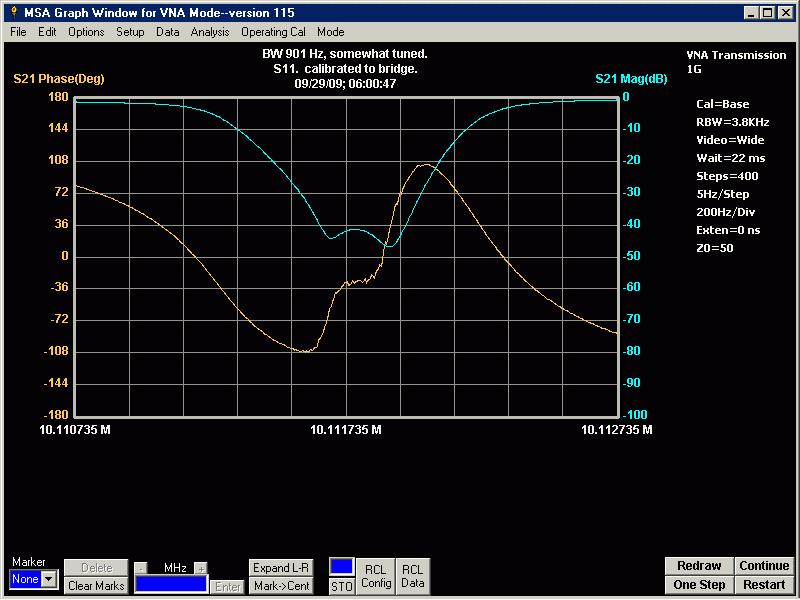Crystal Ladder Filter Board
PWB-CLF-5
Generic, 5-Pole Filter,
With Applications
PWB-CLF-5
Generic, 5-Pole Filter,
With Applications
PWB-CLF-5, Crystal Ladder Filter Board, size-A, 1.2 x 1.2 inch square.
Download SKPWB-CLF-5.sch, Schematic, in ExpressPCB software.
Download PWB-CLF-5.pwb, Printed Wiring Board and Layout, in ExpressPCB software.
The PWB-CLF-5 is a Printed Wiring Board that will accomode up to 5 series crystals. It is based on a generic design that can generate a variety of filter responses. The response of a Crystal Ladder Filter depends entirely on the values of components placed on the board. Therefore, no electrical specifications are assigned to this pwb. Also, no component values are assigned to this pwb.
However, I will include, at the bottom of this page, specifications and component values for some different filters. Each has a different characteristic but uses the same Crystal. You can use the information as a guide for designing other filters. I highly recommend going to the AADE web site and downloading their Filter Design and Analysis software. I created the schematic for this generic board using their ladder component references. However, I use a different topology for impedance transformation.
Here is another crystal ladder filter program. Although limited in its design capability, it is perfect for the PWB-CLF-5 topology. Very easy to use. By Horst Steder, DJ6EV and Jack Hardcastle, G3JIR. To download, go to http://www.arrl.org/qexfiles and find "11x09_Steder-Hardcastle.zip".
Documentation for Generic, 5-pole Crystal Ladder Filter
SKPWB-CLF-5. Schematic for Generic, 5-pole Crystal Ladder Filter

There are no component values called out in the schematic. This is because a variety of filters can be constructed with the same topology, yet have very different operating characteristic. There is one difference from the AADE topology. I am using a low-pass impedance transformation (L/C network).
PWB-CLF-5, Master Artwork for Generic, 5-pole Crystal Ladder Filter

You will notice extra components, not called out in the schematic. It is likely that a required component value is not a standard value. The supplemental (x) components can be added to achieve the proper values. Not all components are used, depending on the type of Response. Some are replaced with shorts or zero ohm resistors.
Layout, Parts Placements for Generic, 5-pole Crystal Ladder Filter

This view shows component placement and fence locations. The blue lines indicate the fences. Each section of the filter is isolated from the next section. This isolation is very important to obtain good Ultimate Rejection Ratio. You might not see this method of fencing in many radio filters. For Single Sideband or CW filtering, extremely high rejection is not usually necessary. The human ear can not discern out-of-band signals that are greater than about 50 dB below the main signal of interest. However, for a spectrum analyzer, the rejection ratio must be better than 70 dB. The following screen print shows the fencing without component placements.
Trace Layer for Generic, 5-pole Crystal Ladder Filter, showing Fences

The crystals (X3-11) and the RF connectors (J1, J2) are installed from the bottom side of the board. The internal fences are installed on the top side of the board, the trace side. When the module is complete, each section will have its own separate top cover soldered in place. The perimeter fence should be about .5 inch high and extend below the bottom of the board so that it can be soldered on both sides. The internal fences should also be .5 inches high. This will make them extend about .1 inch above the perimeter
fence. This makes it much easier to cut and install the top covers for each section.
I recommend using coffee can lids (tin plated steel) for fences and covers. It can be cut with scissors, although I don't suggest using your wife's sewing scissors.
Bottom Ground Layer, as viewed from the top

Construction Hints for Generic, 5-pole Crystal Ladder Filter:
1. Do not install the fences.
2. Install the components on the top side of the board. Do not install the attenuators. They will inhibit testing.
3. Install the two connectors on the bottom side of the board.
4. Install the five crystals from the bottom side of the board.
5. Test the filter without variable tuning components. You should expect very poor Ultimate Rejection Ratio, due to the missing fences. That is fine. You are concerned only with S11 Magnitude return loss, and S21 bandpass response.
5a. If the filter has respectable S21 and S11 data, install the internal fences and then install the perimeter fence. Test the filter again to verify the S11 and S21 data has not changed much. Expect a minor amount of S11 Magnitude return loss change. Install the individual top covers.
5b. If the filter has poor response, change the components to variable components, or you can try adding small amounts of capacitance across the fixed capacitors to change the response. This is not the best way to tune a filter because you can add capacitance, but you cannot subtract capacitance.
Results of a Specific Crystal Ladder Filter Design
The following are results of a Crystal Ladder Filter I designed and constructed, using the PWB-CLF-5. I have given it a preliminary part number of SLIM-CLF-10.11/1.0 The Crystals used are 10.11 MHz, and the design bandwidth goal was 1.0 KHz. For actual filter component values, see the Table at the bottom of the page. These are the average motional characteristics of the 5 crystals, PN: N10.11 PDI.
Fs = 10.11099705 MHz, Fp = 10.12984 MHz, Lm = 20.83468 mH, Cm = .0119 pF, Rm = 10.97 ohms, Cp = 3.182 pF. The 5 crystals were selected from a batch of 85 that were close in Fs (10 Hz) and Rm (2 ohms).
S21 plot of completed SLIM filter with shields in place, showing -3dB points






